Faba Beans
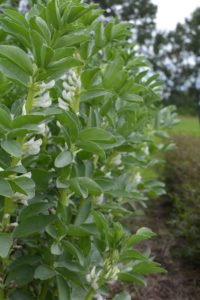
What are faba beans?
Faba beans (or fava or broad bean) are a pulse crop that is part of the legume family. The word “pulse” comes from the Latin word puls, meaning potage or thick soup. Pulses are the dry edible seeds of pod plants and are high in protein and fibre and low in fat.
The common cultivated faba bean (Vicia faba minor) is an annual plant with coarse, upright unbranched stems. Classically, the faba bean is divided into three subspecies based primarily on seed size:
- faba major – the large Chinese broad bean;
- faba equine – the small seeded horse bean; and
- faba minor – the tick bean.
Faba (fava) bean is grown and marketed for its edible seeds (which are the beans)—a source of protein and energy. They can be purchased fresh in the pod, large and dried, small and dried, canned, frozen, or in a fresh cold sealed pack. Shelling fresh beans takes a bit of work—you must open the pod and remove the beans. Blanch them in boiling water for 30 seconds, then place them in a bowl of ice water to stop the cooking process. Now you can easily remove their outer skins, although it is a step by step process!
Faba beans are sold for both human consumption (including fractionation) and for livestock feed or fodder (hay, silage, and straw). Fractions include protein, starch, and fibre for multiple markets.
There are two types of faba bean varieties – tannin and low tannin (zero tannin). Zero tannin varieties are better suited for livestock feed. Tannin-containing varieties are digested easily by ruminants (dairy or beef cattle) but not monogastrics such as swine or poultry.
Where do faba beans grow?
Faba beans are grown across the province and exported to areas like the Mediterranean, Middle East and Asia. Historically, competition has been from France, United Kingdom and Australia.
Faba beans have made a return to Alberta – originally grown to supply the hog feed market, acres of faba beans declined as hog production declined in the province. As demand increases for faba beans in the human food market and as a protein source in other feed formulations, there has been a slow increase of faba bean acres across the province. In addition to tannins in faba bean, other anti-nutritional factors in faba bean include pyrimidine glycosides vicine and convicine.
In spite of the vast nutritional and environmental benefits provided by faba bean cultivation, its use as a food crop has been restricted, primarily due to the presence of the pyrimidine glycosides vicine and convicine (v-c). Ingestion of v-c can cause favism in individuals with a genetically inherited deficiency in glucose-6-phosphate dehydrogenase (G6PD). In monogastric animals, v-c can cause decreased feeding efficiency. The elimination of these glucosides is a goal of most faba bean breeding programs worldwide. (https://www.sciencedirect.com/science/article/pii/S0924224419301992 )
In 2019, Alberta’s pulse growers grew 38,500 metric tonnes of faba beans on 31,500 acres. Statistics were not available for farm cash receipts, export value, or top export countries.
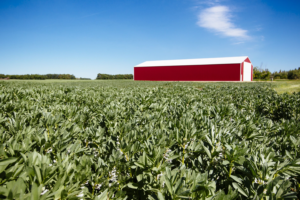
Consider growing faba beans if …
- You live in Southern Alberta, Central Alberta, or the Peace River Region.
- You’re looking for a hardy cool-season crop that can tolerate frost.
- You’re growing on deep, medium-textured soils that have good water holding capacity.
- You want to spread out your workload with early seeding and harvest.
- You want a rotational option in areas where root diseases make pea production challenging.
- You’re looking for a pulse crop that has good lodging resistance.
- You’re interested in marketing flexibility that includes markets for both human consumption and animal feed.
- You want to reduce your input costs (as pulses are nitrogen fixing); break disease cycles in your field; obtain a second-year yield boost in other crops following a pulse crop; improve your soil health; promote soil conversation and sustainable farming practices; and improve farm profitability.
Description
Faba bean is an erect-growing annual legume with a thick, firm stem that supports a height of one to two metres tall with one or more strong, hollow stems coming from the base, with green foliage. The stem turns dark at maturity. Faba bean has the ability to form tillers under Alberta growing conditions.
Leaf Structures
Faba bean leaves are much larger than other pulses such as chickpeas, lentils, and peas. The leaves are pinnately compound (i.e. featherlike) with two to six leaflets each.
Leaves can be up to 8 cm in length (just over 3 inches) in an alternating arrangement. The first true leaf is produced at the third node position. The first two leaves consist of two leaflets each and remaining leaves consist of three or more leaflets. Faba bean plants are without tendrils, or with only rudimentary tendrils.
Growth is rapid during the vegetative stages and faba bean seedlings can produce new nodes (growing points) every five days. As the crop matures, the lower leaves blacken with age and drop, and the bottom pods turn black and dry from the bottom to the top of the plant. The faba bean has a large tap root and extensive secondary root system.

Reproductive nodes (flower)
Flowers can be pure white, purple or pink and each cluster may produce one to six pods.
Flowering occurs in 45 to 65 days, and maturity in 110 to 130 days.
Clusters of one to five flowers are borne on short pedicels, axillary racemes, usually between the 5th to 10th node stage.
All coloured flower types have seed coats that contain tannins and may be suitable for export food markets if seed size and quality match customer demand.
Low tannin varieties are white flowered (without purple flower markings), and the seed has about 15% more usable energy. These large seeded tannin types are preferred for a human edible market (falafel, canned) in Middle East (Egypt) and Asia. (Source: Faba Bean Production 101).
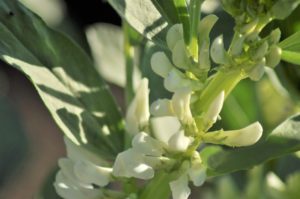
FABA BEAN pods
Pods are long and green, growing up to 10 cm (4 inches) long, 1 to 2 cm (0.4 to 0.8 inches) wide, and contain two to eight seeds per pod. Pods turn brown or black as they mature and seeds turn tan to brown to grey. Pods are not formed from every flower on the plant. Only approximately one quarter of the flowers will produce plants. A faba bean can be both cross and self-pollinated. If pollination does not occur on a particular flower, it will not form a pod (Duc, 1997). Abiotic factors – adequate soil, nutrition, light, and water also influence pod fill (Patrick and Stoddard, 2010). (Source: Alberta Faba Bean Producers Manual)
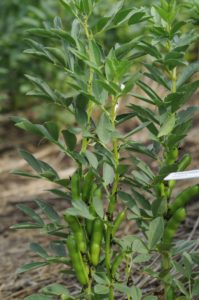
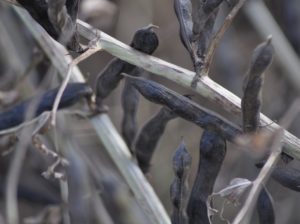
Seed Shape & Size
Oblong/oval seeds weigh between 400 to 800 grams per thousand seeds. Sub-species include a seed weight ranging from 200 to 800 grams per 1,000 seeds, whereas the V. faba major, or broad bean generally has a 1,000 seed weight of over 800 grams. Bushel weight is 60 pounds.

Adaptation Characteristics
Optimal Temperature |
|
Frost & Drought Tolerance |
|
Type |
|
Varieties |
|
Maturity/Dates |
|
Soil |
|
Stages of Development
The life cycle of the faba bean plant has four principal stages:
- germination and emergence
- vegetative stage
- reproductive stage
- senescence (mature stage)
Resources
Resources
Check out the new Faba Bean Staging video here.
- Faba Bean Growth Stages Guide
- Faba Bean Staging Guide to Full Maturity
- Alberta Faba Bean Producers Manual 1.0
- Faba Bean Production 101
Links
History
Faba bean originated in Central Asia, Mediterranean, and South American centres. Cubero postulated a Near Eastern centre of origin, with four radii (1) to Europe (2) along the North African coast to Spain, (3) along the Nile to Ethiopia, and (4) from Mesopotamia to India. Secondary centres of diversity are postulated to include Afghanistan and Ethiopia.(Purdue University)
Commercial production in Canada began in 1972; by 1980, 56,834 acres were cultivated, but acres decreased substantially in 1987 to 26,935 acres as a result of limitations in the export market. Faba beans are grown as a silage crop and as a vegetable; there is increasing interest in smaller-seeded types for use as a source of vegetable oil. (The Canadian Encyclopedia )
Special thanks to Saskatchewan Pulse Growers and Manitoba Pulse & Soybean Growers.
